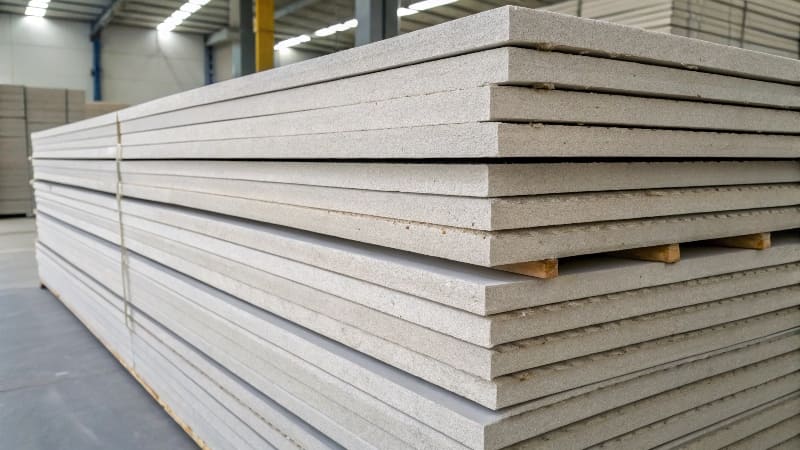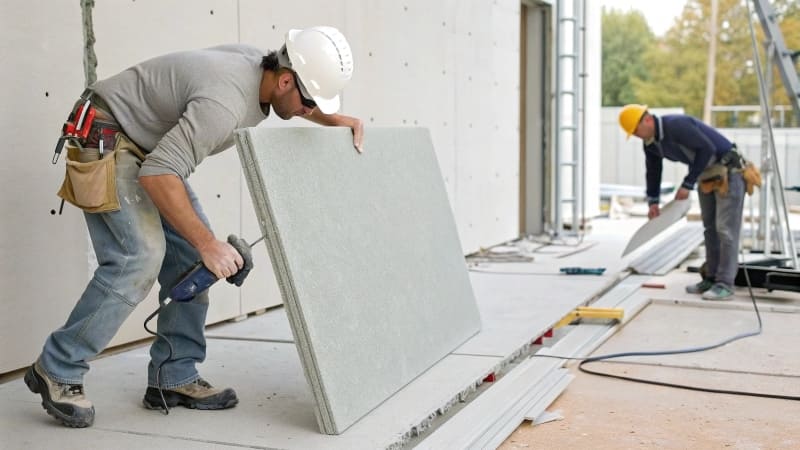How Much Asbestos is in Modern Cement Board?
Many people assume cement board still contains asbestos due to historical associations without understanding modern manufacturing changes. Understanding current cement board composition helps address safety concerns and make informed decisions about building materials and renovation projects.
Modern cement board manufactured after the 1980s contains zero asbestos since manufacturers replaced asbestos fibers with safer alternatives like cellulose, synthetic fibers, and other reinforcing materials that provide equivalent performance without health risks associated with asbestos exposure.
Through decades of cement board manufacturing and working with safety regulations, I learned that the transition from asbestos-containing materials to safer alternatives represents one of the building industry's most significant safety improvements while maintaining product performance and reliability.
Does All Cement Contain Asbestos Naturally?
Understanding cement composition helps clarify asbestos concerns and material safety. Cement itself differs significantly from cement board products in composition and manufacturing processes that affect asbestos presence and safety considerations.
Pure cement does not naturally contain asbestos since cement is manufactured from limestone, clay, and other minerals, while asbestos was historically added as a reinforcing fiber to cement board products but never to basic cement itself during manufacturing processes.
Comprehensive Material Analysis and Safety Understanding
Understanding the distinction between cement and cement board products helps clarify asbestos concerns and safety considerations for various building materials. During my experience working with both cement production and cement board manufacturing, I learned that material composition knowledge prevents unnecessary safety concerns while ensuring appropriate precautions for older materials.
Cement composition includes limestone, clay, silica, and iron ore processed at high temperatures to create hydraulic cement that hardens when mixed with water. This basic cement manufacturing process never involved asbestos addition since cement's binding properties come from chemical reactions rather than fiber reinforcement.
Cement board manufacturing historically added asbestos fibers to cement-based mixtures to improve tensile strength, crack resistance, and durability. Asbestos addition occurred during board manufacturing rather than cement production, making asbestos presence dependent on manufacturing date and product specifications rather than cement content.
Timeline considerations show that asbestos use in cement board peaked from the 1940s through 1980s before being phased out due to health concerns and regulatory changes. Most manufacturers eliminated asbestos by the late 1980s, though some products remained available in certain markets through the 1990s.
Alternative fiber development replaced asbestos with cellulose fibers, synthetic materials, and mineral fibers that provide comparable reinforcement without health risks. Modern fiber cement products achieve superior performance compared to asbestos-containing materials while eliminating safety concerns during manufacturing, installation, and disposal.
Product labeling and documentation from manufacturers typically indicate asbestos content for products manufactured during transition periods. Current manufacturers clearly label products as asbestos-free while older products may require testing for definitive identification of asbestos presence.
Regional variations in asbestos elimination occurred at different times depending on local regulations and market conditions. North American and European markets eliminated asbestos earlier than some developing markets where asbestos-containing products remained available longer.
Manufacturing process changes eliminated asbestos use through reformulated mixtures, improved processing equipment, and quality control systems that ensure consistent performance with safer materials. Modern manufacturing achieves better product consistency and performance than historical asbestos-containing methods.
Health and safety improvements from asbestos elimination benefit workers, installers, and building occupants through reduced exposure risks during manufacturing, installation, maintenance, and demolition activities. Current products require only standard construction safety practices rather than specialized asbestos handling procedures.
Performance comparisons show that modern asbestos-free cement board products often exceed the durability, weather resistance, and structural performance of historical asbestos-containing materials through improved formulations and manufacturing processes.
| Time Period | Asbestos Use Status | Product Performance | Safety Requirements |
|---|---|---|---|
| Pre-1940s | Not commonly used | Basic cement board | Standard construction safety |
| 1940s-1980s | Widely used | Good durability | Asbestos handling required |
| 1980s-1990s | Phase-out period | Variable composition | Testing recommended |
| 1990s-present | Eliminated | Enhanced performance | Standard construction safety |
| Current products | Zero asbestos | Superior durability | No special precautions |
How to Tell if Cement Board Contains Asbestos?
Identifying asbestos-containing cement board requires systematic evaluation approaches since visual inspection alone cannot definitively determine asbestos presence. Understanding identification methods helps ensure appropriate safety precautions and handling procedures for older materials.
Determining asbestos presence in cement board requires checking manufacturing dates, product markings, laboratory testing, and professional evaluation since asbestos fibers are microscopic and cannot be identified through visual inspection or simple field tests alone.
Comprehensive Identification Strategies and Safety Protocols
Accurate asbestos identification in cement board requires multiple evaluation methods since definitive determination often requires laboratory analysis. During my experience working with building renovations and material safety assessments, I learned that systematic identification approaches prevent exposure risks while ensuring appropriate handling procedures for different materials.
Manufacturing date assessment provides initial screening since products manufactured after 1990 rarely contain asbestos while materials from the 1940s-1980s require further evaluation. Building permits, construction documents, and material invoices may provide manufacturing date information for preliminary risk assessment.
Product marking examination includes checking for manufacturer labels, model numbers, and specification information that may indicate asbestos content. Some manufacturers clearly marked asbestos-containing products while others provided coded information that requires manufacturer contact or reference material consultation.
Visual characteristics may suggest asbestos presence though definitive identification requires testing. Asbestos-containing cement board often appears denser, smoother, and more uniform than modern products, though these characteristics vary among manufacturers and product lines making visual assessment unreliable.
Professional testing services provide definitive asbestos identification through polarized light microscopy and transmission electron microscopy that accurately identify asbestos fiber types and concentrations. Professional testing costs typically range from $200-500 per sample depending on analysis complexity and laboratory requirements.
Sample collection procedures require safety precautions including personal protective equipment, containment measures, and proper sample handling to prevent fiber release during collection. Improper sampling can create exposure risks while compromising test accuracy through contamination or inadequate sample size.
Building age correlation helps assess asbestos probability since buildings constructed during peak asbestos use periods (1940s-1980s) more likely contain asbestos materials. However, renovation materials from any period may contain asbestos requiring evaluation regardless of original construction date.
Documentation review includes examining building records, material specifications, and renovation history that may indicate asbestos presence or previous abatement activities. Historical documentation provides valuable context though may not be available or accurate for all properties.
Professional evaluation by certified asbestos inspectors provides comprehensive assessment including material identification, condition evaluation, and safety recommendations. Professional inspection typically costs $300-800 depending on property size and complexity but ensures accurate identification and appropriate safety planning.
Regulatory requirements in many jurisdictions mandate professional testing before renovation or demolition activities that may disturb asbestos-containing materials. Understanding local requirements prevents regulatory violations while ensuring worker and occupant safety during construction activities.
Field testing limitations include the inability to definitively identify asbestos through visual inspection, simple chemical tests, or portable instruments that may provide false results. Only laboratory analysis using approved microscopy methods provides reliable asbestos identification for regulatory and safety purposes.
| Identification Method | Reliability Level | Cost Range | Time Required |
|---|---|---|---|
| Manufacturing date check | Screening only | Free | Immediate |
| Product marking review | Moderate | Free-$50 | 1-2 hours |
| Visual characteristics | Low reliability | Free | Immediate |
| Professional testing | Definitive | $200-500 | 3-7 days |
| Certified inspection | Comprehensive | $300-800 | 1-3 days |
| Documentation review | Moderate | $100-300 | Variable |
Can I Safely Remove Asbestos Cement Board Myself?
Understanding asbestos removal requirements helps ensure safety and legal compliance during renovation projects. DIY asbestos removal involves significant health risks and regulatory considerations that affect project planning and contractor selection decisions.
Asbestos cement board removal typically requires professional abatement contractors due to health risks, regulatory requirements, and specialized procedures, though small amounts may qualify for homeowner removal following strict safety protocols and local regulations in some jurisdictions.
Safety Requirements and Regulatory Compliance Analysis
Asbestos cement board removal involves complex safety and regulatory considerations that typically require professional expertise and specialized equipment. During my experience working with renovation projects and safety compliance, I learned that understanding removal requirements helps ensure appropriate planning and prevents exposure risks for workers and occupants.
Regulatory requirements vary by jurisdiction but typically mandate professional removal for commercial buildings and larger residential projects while some areas allow limited homeowner removal under strict conditions. Understanding local regulations prevents violations and ensures appropriate safety measures for specific project circumstances.
Health risks from asbestos exposure include lung disease, cancer, and other serious conditions that develop years after exposure, making prevention critical during removal activities. Even brief exposure to asbestos fibers can pose health risks, particularly for individuals with existing respiratory conditions or repeated exposure situations.
Professional abatement procedures include containment systems, specialized equipment, personal protective equipment, air monitoring, and waste disposal protocols that ensure worker and occupant safety throughout removal processes. Professional contractors maintain certification, insurance, and equipment necessary for safe asbestos handling.
DIY removal limitations include lack of specialized equipment, training, and containment systems that increase exposure risks and regulatory violations. Improper removal techniques can spread asbestos fibers throughout buildings, creating extensive contamination requiring professional remediation at much higher costs than initial professional removal.
Safety equipment requirements for any asbestos work include respirators, protective clothing, containment materials, and decontamination facilities that prevent fiber spread and worker exposure. Proper equipment costs and training requirements often exceed project savings from DIY approaches while providing inferior safety protection.
Containment procedures prevent asbestos fiber spread through negative air pressure systems, plastic barriers, and sealed work areas that isolate removal activities from occupied spaces. Inadequate containment allows fiber migration that can contaminate entire buildings requiring extensive cleanup and testing.
Waste disposal requirements mandate special handling, packaging, and disposal at approved facilities that accept asbestos-containing materials. Improper disposal violates environmental regulations and creates ongoing exposure risks for waste handlers and communities.
Testing and clearance procedures verify successful removal completion through air sampling and surface testing that confirms safe occupancy following abatement activities. Professional testing ensures removal effectiveness while documenting regulatory compliance for future reference.
Insurance considerations may void coverage for DIY asbestos removal or resulting damage while professional contractors typically carry specialized insurance for asbestos work. Understanding insurance implications prevents financial exposure from accidents, health claims, or property damage during removal activities.
Cost comparisons should include equipment, disposal, testing, and potential remediation costs for improper removal rather than focusing only on contractor fees. Professional removal often costs less than DIY approaches when all factors are considered while providing superior safety protection and regulatory compliance.
| Removal Approach | Safety Level | Regulatory Compliance | Total Cost Consideration |
|---|---|---|---|
| Professional abatement | Highest | Full compliance | Contractor fees, testing, disposal |
| Limited homeowner removal | Moderate (with training) | Varies by jurisdiction | Equipment, training, disposal, testing |
| Improper DIY removal | Very low | Violations likely | Initial costs plus remediation expenses |
| Encapsulation alternatives | High (when appropriate) | Usually compliant | Professional assessment and installation |
| Leave in place | High (if undisturbed) | Compliant | Monitoring and maintenance only |
Conclusion
Modern cement board contains zero asbestos since manufacturers eliminated asbestos in the 1980s-1990s, replacing it with safer fibers, while older cement board requires professional testing for identification and typically needs professional removal due to health risks and regulatory requirements.



